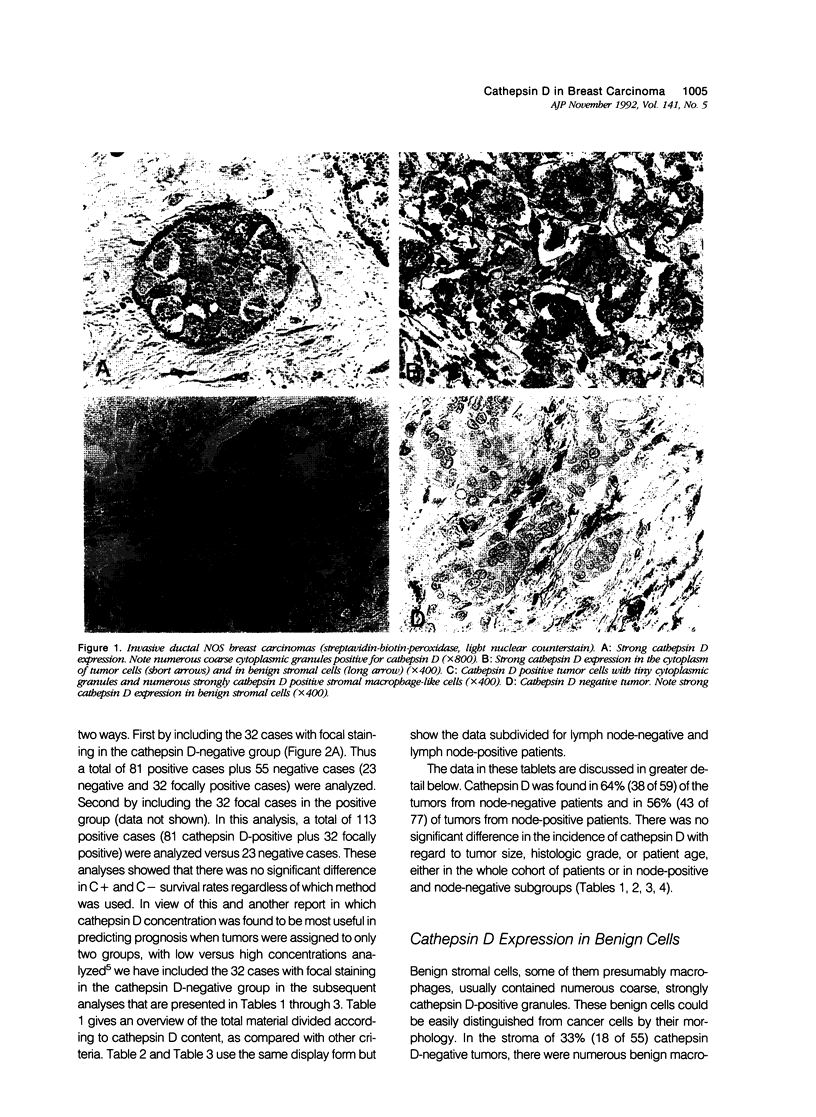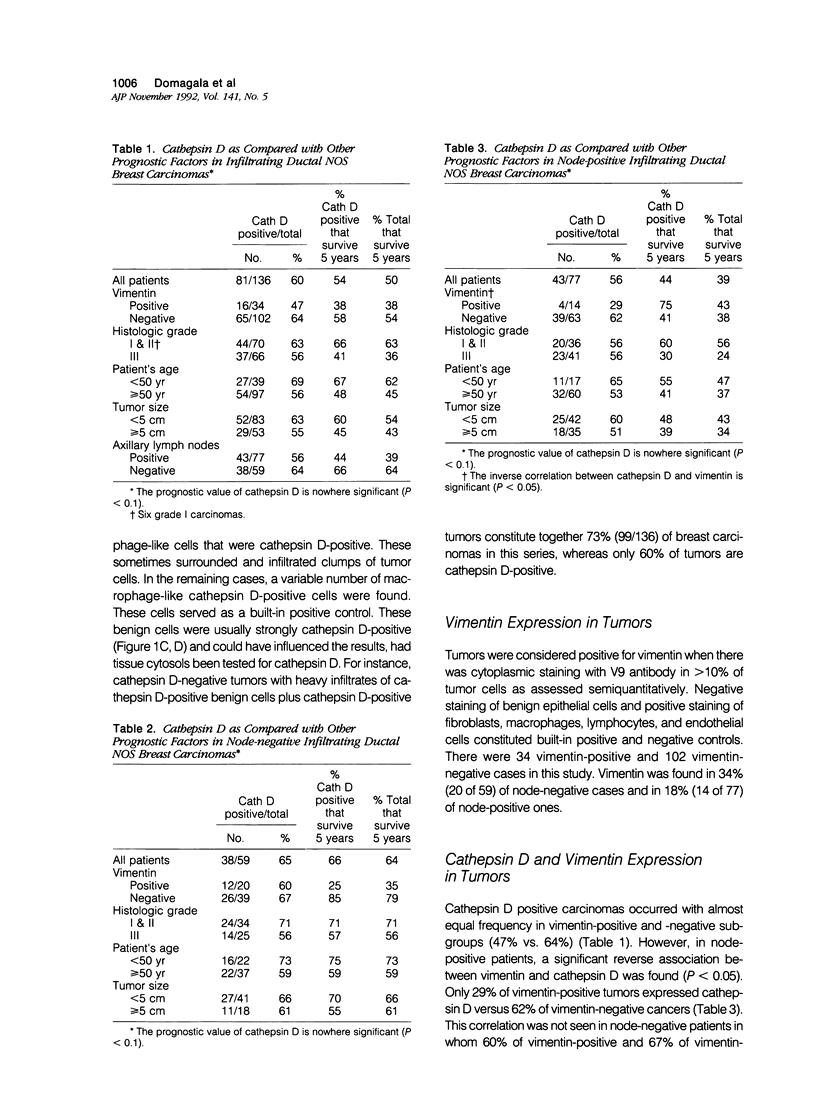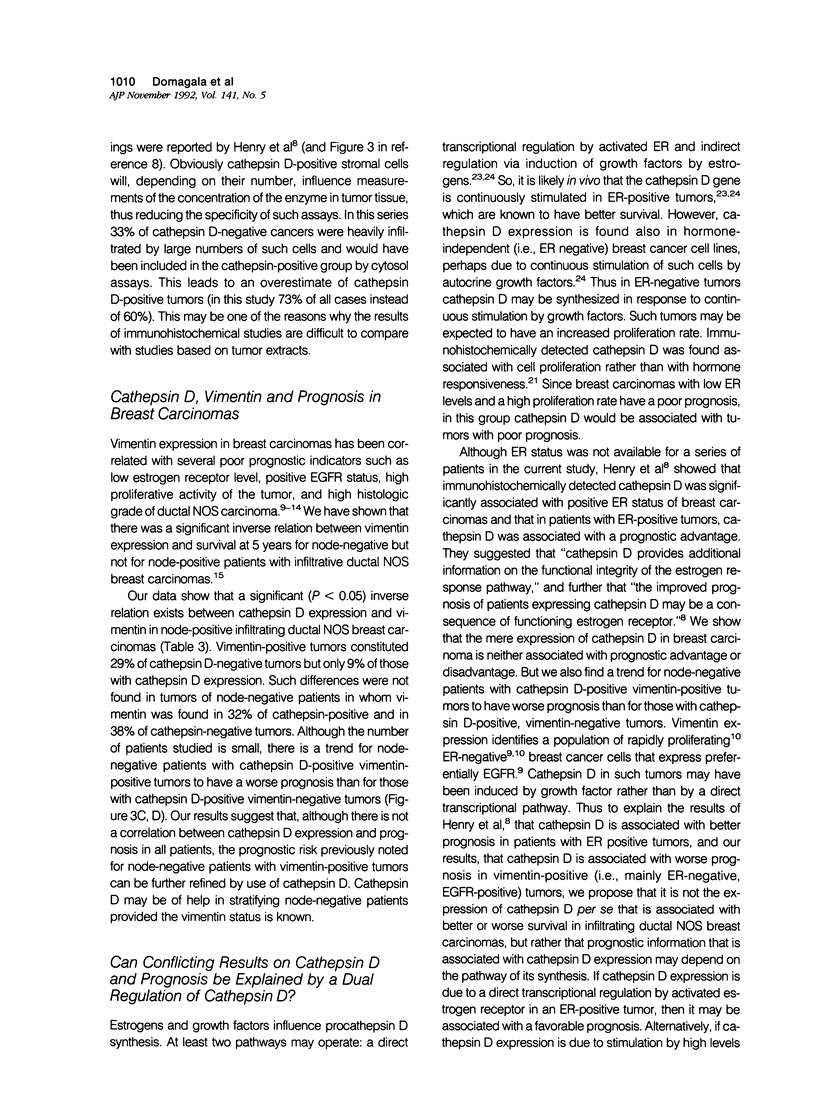Abstract
Cathepsin D expression was assessed by immunohistochemistry in 59 node-negative and 77 node-positive infiltrative ductal not otherwise specified (NOS) breast carcinomas and compared with overall survival at 90 months. Cancer cells in 60% (81/136) of the tumors expressed cathepsin D. In the stroma of 33% (18 of 55) cathepsin D negative tumors, numerous strongly cathepsin D positive, benign macrophage-like cells were found. Multivariate analysis showed no significant correlation of cathepsin D expression and overall survival for all patients for node-negative and node-positive patients and for patients with vimentin-positive and -negative tumors. However, in node-negative but not in node-positive patients, a trend for better survival for patients with cathepsin-positive vimentin-negative tumors and worse survival for those with cathepsin-positive vimentin-positive tumors was noted. Due to the low number of patients in these subgroups, neither trend reached significance. Cathepsin D expression was independent of patient age, size, and histologic grade of tumor, and vimentin expression. However, in the node-positive group, negative correlation of cathepsin D and vimentin expression was found. We suggest that prognostic significance of cathepsin D in infiltrative ductal NOS breast carcinomas may be associated with the pathway of its synthesis rather than with its mere presence in tumor cells.
Full text
PDF









Images in this article
Selected References
These references are in PubMed. This may not be the complete list of references from this article.
- BLOOM H. J., RICHARDSON W. W. Histological grading and prognosis in breast cancer; a study of 1409 cases of which 359 have been followed for 15 years. Br J Cancer. 1957 Sep;11(3):359–377. doi: 10.1038/bjc.1957.43. [DOI] [PMC free article] [PubMed] [Google Scholar]
- Capony F., Rougeot C., Montcourrier P., Cavailles V., Salazar G., Rochefort H. Increased secretion, altered processing, and glycosylation of pro-cathepsin D in human mammary cancer cells. Cancer Res. 1989 Jul 15;49(14):3904–3909. [PubMed] [Google Scholar]
- Cattoretti G., Andreola S., Clemente C., D'Amato L., Rilke F. Vimentin and p53 expression on epidermal growth factor receptor-positive, oestrogen receptor-negative breast carcinomas. Br J Cancer. 1988 Apr;57(4):353–357. doi: 10.1038/bjc.1988.81. [DOI] [PMC free article] [PubMed] [Google Scholar]
- Domagala W., Lasota J., Bartkowiak J., Weber K., Osborn M. Vimentin is preferentially expressed in human breast carcinomas with low estrogen receptor and high Ki-67 growth fraction. Am J Pathol. 1990 Jan;136(1):219–227. [PMC free article] [PubMed] [Google Scholar]
- Domagala W., Lasota J., Dukowicz A., Markiewski M., Striker G., Weber K., Osborn M. Vimentin expression appears to be associated with poor prognosis in node-negative ductal NOS breast carcinomas. Am J Pathol. 1990 Dec;137(6):1299–1304. [PMC free article] [PubMed] [Google Scholar]
- Domagala W., Woźniak L., Lasota J., Weber K., Osborn M. Vimentin is preferentially expressed in high-grade ductal and medullary, but not in lobular breast carcinomas. Am J Pathol. 1990 Nov;137(5):1059–1064. [PMC free article] [PubMed] [Google Scholar]
- Garcia M., Derocq D., Pujol P., Rochefort H. Overexpression of transfected cathepsin D in transformed cells increases their malignant phenotype and metastatic potency. Oncogene. 1990 Dec;5(12):1809–1814. [PubMed] [Google Scholar]
- Garcia M., Salazar-Retana G., Richer G., Domergue J., Capony F., Pujol H., Laffargue F., Pau B., Rochefort H. Immunohistochemical detection of the estrogen-regulated 52,000 mol wt protein in primary breast cancers but not in normal breast and uterus. J Clin Endocrinol Metab. 1984 Sep;59(3):564–566. doi: 10.1210/jcem-59-3-564. [DOI] [PubMed] [Google Scholar]
- Henry J. A., McCarthy A. L., Angus B., Westley B. R., May F. E., Nicholson S., Cairns J., Harris A. L., Horne C. H. Prognostic significance of the estrogen-regulated protein, cathepsin D, in breast cancer. An immunohistochemical study. Cancer. 1990 Jan 15;65(2):265–271. doi: 10.1002/1097-0142(19900115)65:2<265::aid-cncr2820650214>3.0.co;2-1. [DOI] [PubMed] [Google Scholar]
- Maudelonde T., Khalaf S., Garcia M., Freiss G., Duporte J., Benatia M., Rogier H., Paolucci F., Simony J., Pujol H. Immunoenzymatic assay of Mr 52,000 cathepsin D in 182 breast cancer cytosols: low correlation with other prognostic parameters. Cancer Res. 1988 Jan 15;48(2):462–466. [PubMed] [Google Scholar]
- Osborn M., Debus E., Weber K. Monoclonal antibodies specific for vimentin. Eur J Cell Biol. 1984 May;34(1):137–143. [PubMed] [Google Scholar]
- Raymond W. A., Leong A. S. Co-expression of cytokeratin and vimentin intermediate filament proteins in benign and neoplastic breast epithelium. J Pathol. 1989 Apr;157(4):299–306. doi: 10.1002/path.1711570406. [DOI] [PubMed] [Google Scholar]
- Raymond W. A., Leong A. S. Vimentin--a new prognostic parameter in breast carcinoma? J Pathol. 1989 Jun;158(2):107–114. doi: 10.1002/path.1711580205. [DOI] [PubMed] [Google Scholar]
- Rochefort H., Augereau P., Briozzo P., Capony F., Cavailles V., Freiss G., Garcia M., Maudelonde T., Morisset M., Vignon F. Structure, function, regulation and clinical significance of the 52K pro-cathepsin D secreted by breast cancer cells. Biochimie. 1988 Jul;70(7):943–949. doi: 10.1016/0300-9084(88)90236-2. [DOI] [PubMed] [Google Scholar]
- Rochefort H., Capony F., Garcia M. Cathepsin D in breast cancer: from molecular and cellular biology to clinical applications. Cancer Cells. 1990 Dec;2(12):383–388. [PubMed] [Google Scholar]
- Rochefort H., Capony F., Garcia M., Cavaillès V., Freiss G., Chambon M., Morisset M., Vignon F. Estrogen-induced lysosomal proteases secreted by breast cancer cells: a role in carcinogenesis? J Cell Biochem. 1987 Sep;35(1):17–29. doi: 10.1002/jcb.240350103. [DOI] [PubMed] [Google Scholar]
- Rochefort H., Cavailles V., Augereau P., Capony F., Maudelonde T., Touitou I., Garcia M. Overexpression and hormonal regulation of pro-cathepsin D in mammary and endometrial cancer. J Steroid Biochem. 1989;34(1-6):177–182. doi: 10.1016/0022-4731(89)90080-0. [DOI] [PubMed] [Google Scholar]
- Sainsbury J. R., Farndon J. R., Needham G. K., Malcolm A. J., Harris A. L. Epidermal-growth-factor receptor status as predictor of early recurrence of and death from breast cancer. Lancet. 1987 Jun 20;1(8547):1398–1402. doi: 10.1016/s0140-6736(87)90593-9. [DOI] [PubMed] [Google Scholar]
- Spyratos F., Maudelonde T., Brouillet J. P., Brunet M., Defrenne A., Andrieu C., Hacene K., Desplaces A., Rouëssé J., Rochefort H. Cathepsin D: an independent prognostic factor for metastasis of breast cancer. Lancet. 1989 Nov 11;2(8672):1115–1118. doi: 10.1016/s0140-6736(89)91487-6. [DOI] [PubMed] [Google Scholar]
- Tandon A. K., Clark G. M., Chamness G. C., Chirgwin J. M., McGuire W. L. Cathepsin D and prognosis in breast cancer. N Engl J Med. 1990 Feb 1;322(5):297–302. doi: 10.1056/NEJM199002013220504. [DOI] [PubMed] [Google Scholar]
- Thorpe S. M., Rochefort H., Garcia M., Freiss G., Christensen I. J., Khalaf S., Paolucci F., Pau B., Rasmussen B. B., Rose C. Association between high concentrations of Mr 52,000 cathepsin D and poor prognosis in primary human breast cancer. Cancer Res. 1989 Nov 1;49(21):6008–6014. [PubMed] [Google Scholar]



